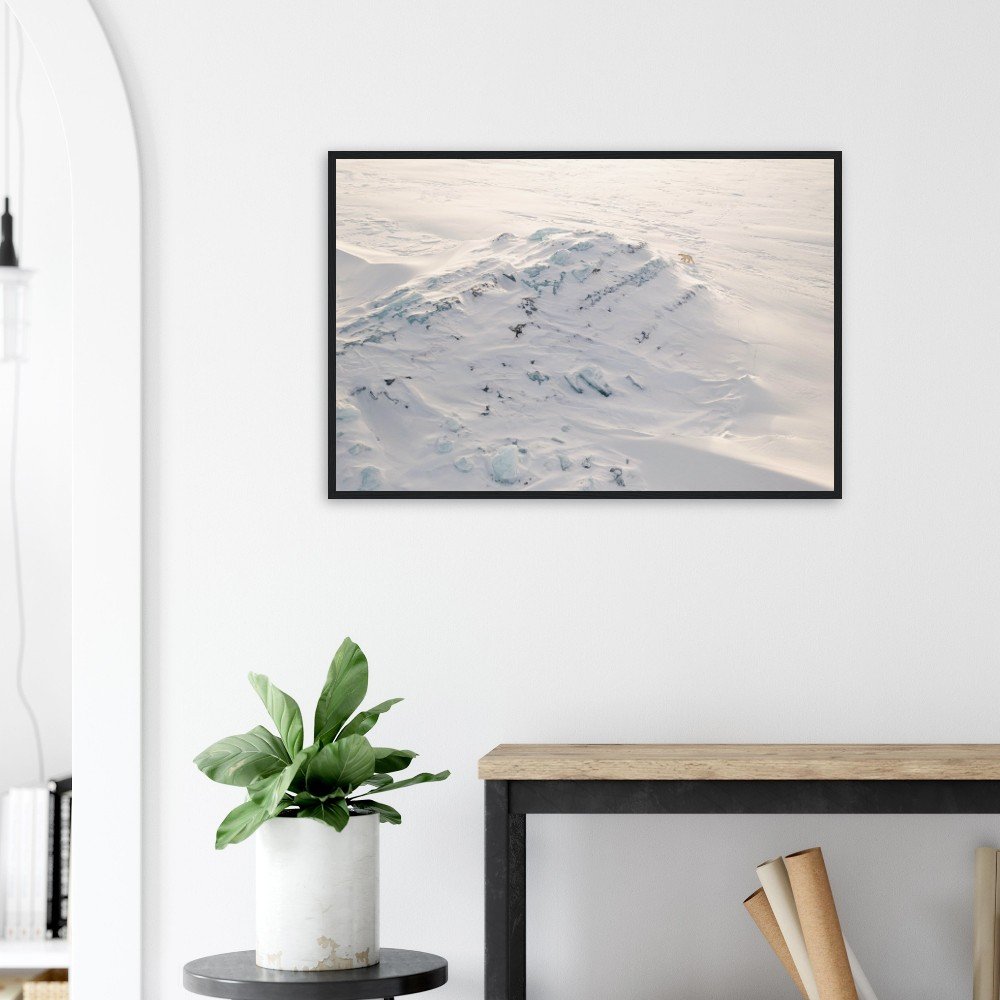Polar bear and iceberg
from US$95.42
The sea around Svalbard freezes up for several months a year. This is the preferred habitat of the polar bear, the apex predator in the Arctic. The glacier ice that has been calved throughout the open water season from adjacent glaciers terminating in the sea, creates a conglomerate of icebergs trapped in the sea-ice during the winter. This provides a three-dimensional habitat for the ringed seals, which use the drifted snow around the icebergs to give their breathing holes through the sea-ice a roof, making it easier to build galleries for the pups that are born in April. Ringed seals are the primary prey of polar bears, so it is common to see them patrolling the icebergs on the hunt for seal galleries, that the bears detect through a powerful sense of smell. In the image, a young male polar bear walks around a massive iceberg in the East coast of Svalbard.
---------------
El mar alrededor de Svalbard se congela durante varios meses al año. Este es el hábitat preferido del oso polar, el máximo depredador del Ártico. El hielo que se ha desprendido durante la temporada de aguas abiertas de los glaciares adyacentes que terminan en el mar, crea un conglomerado de icebergs atrapados en el hielo marino durante el invierno. Esto proporciona un hábitat tridimensional para las focas anilladas, que utilizan la nieve acumulada alrededor de los icebergs para darle un techo a sus orificios, los cuales utilizan para respirar a través del hielo marino, lo que facilita la construcción de galerías para las crías que nacen en Abril. Las focas anilladas son la principal presa de los osos polares, por lo que es común verlos patrullando los icebergs en busca de galerías de focas, que detectan a través de un poderoso sentido del olfato. En la imagen, un joven macho de oso polar camina alrededor de un enorme iceberg en la costa este de Svalbard.
Tamaño:
Quantity:
The sea around Svalbard freezes up for several months a year. This is the preferred habitat of the polar bear, the apex predator in the Arctic. The glacier ice that has been calved throughout the open water season from adjacent glaciers terminating in the sea, creates a conglomerate of icebergs trapped in the sea-ice during the winter. This provides a three-dimensional habitat for the ringed seals, which use the drifted snow around the icebergs to give their breathing holes through the sea-ice a roof, making it easier to build galleries for the pups that are born in April. Ringed seals are the primary prey of polar bears, so it is common to see them patrolling the icebergs on the hunt for seal galleries, that the bears detect through a powerful sense of smell. In the image, a young male polar bear walks around a massive iceberg in the East coast of Svalbard.
---------------
El mar alrededor de Svalbard se congela durante varios meses al año. Este es el hábitat preferido del oso polar, el máximo depredador del Ártico. El hielo que se ha desprendido durante la temporada de aguas abiertas de los glaciares adyacentes que terminan en el mar, crea un conglomerado de icebergs atrapados en el hielo marino durante el invierno. Esto proporciona un hábitat tridimensional para las focas anilladas, que utilizan la nieve acumulada alrededor de los icebergs para darle un techo a sus orificios, los cuales utilizan para respirar a través del hielo marino, lo que facilita la construcción de galerías para las crías que nacen en Abril. Las focas anilladas son la principal presa de los osos polares, por lo que es común verlos patrullando los icebergs en busca de galerías de focas, que detectan a través de un poderoso sentido del olfato. En la imagen, un joven macho de oso polar camina alrededor de un enorme iceberg en la costa este de Svalbard.
The sea around Svalbard freezes up for several months a year. This is the preferred habitat of the polar bear, the apex predator in the Arctic. The glacier ice that has been calved throughout the open water season from adjacent glaciers terminating in the sea, creates a conglomerate of icebergs trapped in the sea-ice during the winter. This provides a three-dimensional habitat for the ringed seals, which use the drifted snow around the icebergs to give their breathing holes through the sea-ice a roof, making it easier to build galleries for the pups that are born in April. Ringed seals are the primary prey of polar bears, so it is common to see them patrolling the icebergs on the hunt for seal galleries, that the bears detect through a powerful sense of smell. In the image, a young male polar bear walks around a massive iceberg in the East coast of Svalbard.
---------------
El mar alrededor de Svalbard se congela durante varios meses al año. Este es el hábitat preferido del oso polar, el máximo depredador del Ártico. El hielo que se ha desprendido durante la temporada de aguas abiertas de los glaciares adyacentes que terminan en el mar, crea un conglomerado de icebergs atrapados en el hielo marino durante el invierno. Esto proporciona un hábitat tridimensional para las focas anilladas, que utilizan la nieve acumulada alrededor de los icebergs para darle un techo a sus orificios, los cuales utilizan para respirar a través del hielo marino, lo que facilita la construcción de galerías para las crías que nacen en Abril. Las focas anilladas son la principal presa de los osos polares, por lo que es común verlos patrullando los icebergs en busca de galerías de focas, que detectan a través de un poderoso sentido del olfato. En la imagen, un joven macho de oso polar camina alrededor de un enorme iceberg en la costa este de Svalbard.





